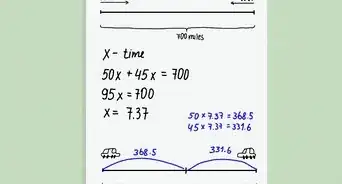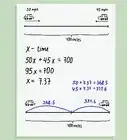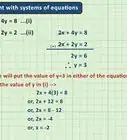wikiHow is a “wiki,” similar to Wikipedia, which means that many of our articles are co-written by multiple authors. To create this article, 11 people, some anonymous, worked to edit and improve it over time.
This article has been viewed 170,836 times.
Learn more...
A mathematical model is a description of a system using mathematical language. Mathematical models are used not only in the natural sciences and engineering disciplines but they are also used in biology, economics and sociology. Mathematical models can range from simple to complex.[1] Keep reading to learn how to build a mathematical model.
Steps
Preparing to Make a Mathematical Model
-
1Determine what you want to know. What is the objective of creating a model? Make a list of the data you want to find by using the model. It is crucial to ask this question before you create your model or you may end up creating a model that does not meet your objective.[2]
- Do you want to predict something? Find out how to regulate something? Or do something else?[3]
- For example, imagine you want to know how much room you have in a storage unit to see how many boxes you can put into it. You will be creating a model to predict the amount of space that is in your storage unit.
-
2Determine what you already know. What data do you already have? Make a list of the data that has been given. As you list the data, decide what pieces are most relevant and which pieces are not relevant.[4]
- You should also list any information that can be assumed based on what you already know.
- Keep in mind that you may have to take measurements to find the data that you need.
- To find out how much room you have in your storage unit, you will need to measure the unit's height, width, and length.
Advertisement -
3Determine the physical principles that govern the model you want to create. Do you need to consider factors like gravity, volume, time, etc.? Make a note of any factors that will need to be considered when you create the model.[5]
- To determine the amount of space that you have in your storage unit, you will need to find the volume.
- You also need to keep in mind that there will be some wasted space, since some objects may be irregular and that will make it difficult to use every inch of the storage unit.[6]
-
4Identify the equations that you will need to use to find your answer. What equations and formulas will you need in order to find your answer? How will you apply these equations and formulas? Make sure that you have a clear understanding of how to plug the data that you have into the equation.
- To find the volume of the storage unit, you will need to use the equation V= h x w x l[7]
-
5Look at what others have done. There is no need to re-invent the wheel if somebody else has developed a model that may suit your purposes already. Check in your textbook or ask your teacher. Just remember to make sure that someone else’s model will work for your situation.[8]
- To get an idea of how to find the volume using the equation you have identified, check your textbook or ask your teacher.
-
6Create a diagram for your model. A simple mathematical model may not require a diagram. However, if you are creating a complex model, a diagram may help you determine if your model will work. Draw a diagram to represent the actual model you plan to make.
- Make sure to incorporate your data into your diagram to help guide you when you create the actual model.
Making a Mathematical Model
-
1Create your model. Once you have finished the planning phase, you should be able to create your model. Use your diagram, data, and other information to make your mathematical model. Make sure to check your notes often to ensure accuracy.[9]
- Make sure that your model represents the actual relationship among your data that you are trying to accomplish.
- For more advanced models, you may need to use a computer program.
-
2Test your model. It is important to verify the validity of your model’s results before you try to do anything else with your model. Apply your data and see if the model is valid. Are your results what you expected? Do they make sense? Are the results repeatable?[10]
- Solve the equation V = h x w x l to determine if your results make sense. Repeat the solution to determine if your results are repeatable.
-
3Determine how the model could be improved. In order to make your model useful for further applications, you need to consider how it could be improved. Are there any variables that you should have considered? Are there any restrictions that could be lifted? Try to find the best way to improve upon your model before you use it again.[11]
- For example, if you want to have 3 feet (0.91 m) of space to walk through your storage unit, you could adjust your equation to account for that space. Just deduct the space you will lose from the appropriate number in your equation. In this case, you could adjust your equation to read V = h x (w-3) x l[12]
- After you have identified ways to improve your model, make the changes and test it again.
Community Q&A
-
QuestionWhat is the expression for the volume of cylinder?
 DonaganTop AnswererV = πr²h, where V is the volume, π is 3.14159, r is the radius, and h is the height.
DonaganTop AnswererV = πr²h, where V is the volume, π is 3.14159, r is the radius, and h is the height. -
QuestionWhat is a mathematical model? Please explain in simple terms.
 DonaganTop AnswererIt is a numerical study of almost anything. It is commonly used in designing things (buildings, bridges, and cars, for example), as well as predicting the future (such as weather patterns or human behavior).
DonaganTop AnswererIt is a numerical study of almost anything. It is commonly used in designing things (buildings, bridges, and cars, for example), as well as predicting the future (such as weather patterns or human behavior).
References
- ↑ https://www.mathsisfun.com/algebra/mathematical-models.html
- ↑ http://www.sfu.ca/~vdabbagh/Chap1-modeling.pdf
- ↑ https://people.maths.bris.ac.uk/~madjl/course_text.pdf
- ↑ http://www.sfu.ca/~vdabbagh/Chap1-modeling.pdf
- ↑ http://www.sfu.ca/~vdabbagh/Chap1-modeling.pdf
- ↑ https://www.mathsisfun.com/algebra/mathematical-models.html
- ↑ https://www.mathsisfun.com/algebra/mathematical-models.html
- ↑ https://math.libretexts.org/Bookshelves/Scientific_Computing_Simulations_and_Modeling/Book%3A_Introduction_to_the_Modeling_and_Analysis_of_Complex_Systems_(Sayama)/04%3A_DiscreteTime_Models_I__Modeling/405%3A_Building_Your_Own_Model_Equation
- ↑ https://www.ncbi.nlm.nih.gov/pmc/articles/PMC7152750/
About This Article
Mathematical models help to represent a system using mathematical language, and you can make your own to predict outcomes and solve problems. First, figure out what information you already know and what information you need to solve. Then, write any equations you’ll need to find your answer. For example, to find the volume of a storage unit, you’ll need to use the equation V= h x w x. If you don't know what formula you need, try looking it up online. You can also draw a diagram to use as a map when you make your model. For a more advanced model, you can even design it using computer software before you build it physically. Use your equation, diagram, and any other data you have to make your model. Now you can test your model and compare it with your predicted results. For more tips, including how to find inspiration for your mathematical model, read on!



































































